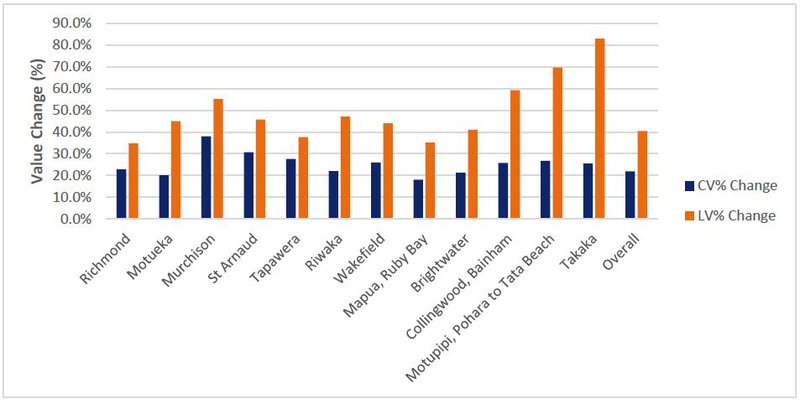New rating valuations for Tasman District

Tasman District property owners will soon receive a Notice of Rating Valuation in the post with an updated rating value for their property.
The new rating valuations have been prepared for 25,987 properties on behalf of the Tasman District Council by Quotable Value (QV). They show the total rateable value for the district is now $22,860,281,000 with the land value of those properties now valued at $12,863,394,000.
Rating valuations are usually carried out on all New Zealand properties every three years to help local councils set rates for the following three-year period. They reflect the likely selling price of a property at the effective revaluation date, which was 1 October 2020, and do not include chattels.
The revaluation does not increase or decrease the council’s total rating income but it does affect how rates are allocated. If the council’s rates income charged on rateable value was a pie, a ratepayer’s slice of the pie might get bigger if their property value has increased by more than the average.
Tasman residential rating values climb 22% since 2017
On average, the value of residential housing has increased 22% since 2017 with the average house value now sitting at $682,000, while the corresponding average land value increased by 40% to an average of $361,000.
QV valuer Richard Kolff commented: “The demand for residential housing was buoyant across the region, with most townships in the district seeing increases of between 18-30% overall. Demand for sections has also been strong and as a result land values have increased 40% for the district overall.”
“We have seen significant value lifts across the entire residential market since 2017 with values still rising strongly. Lower value properties have seen the most competition from buyers and has resulted in the greatest value increases. Demand from buyers coming from outside the region has helped fuel the market. This demand extends to holiday homes, although there have been lesser increases for beachfront properties with historic flooding issues, or those that are considered to be at risk of rising sea levels.”
Since 2017, the average capital value of an improved lifestyle property has increased by 20.3% to $1,044,000, while the corresponding land value for a lifestyle property increased by 31.6% to $539,000.
“Lifestyle properties typically align in value with high-end residential properties and this segment of the market has been buoyant. A smaller market and less demand has meant there hasn’t been quite the same increase in the land values as seen in the residential market,” Mr Kolff added.

Smaller rises for commercial & industrial property
Commercial property values have increased by 16%, and property values in the industrial sector have increased by 18% since the district’s last rating valuation in 2017. Commercial and industrial land values have also increased by 22% and 32% respectively.
“Retail and office properties have seen lower increases in value than the residential property market,” said Mr Kolff. “While there is demand from buyers for good quality properties with favourable leases in place, this has been offset to some degree by online competition for retailers and the start of a post lockdown trend for more people to work from home.
“There is steady value increases for industrial properties and a limited supply of industrial land within the region has seen a boost in land values”
More on rating valuations
It is helpful to remember the effective rating revaluation date of 1 October 2020 has passed and any changes in the market since then will not be included in the new rating valuations.
This means in many cases a sale price achieved in the market today may be different to the new rating valuation set as at 1 October 2020 and that rating valuations are not designed to be used as market valuations for raising finance with banks or as insurance valuations.
The updated rating valuations are independently audited by the Office of the Valuer General and need to meet rigorous quality standards before the new rating valuations are certified.
New rating values will be posted to property owners after 27 January 2021. If owners do not agree with their rating valuation, they have a right to object through the objection process before 5 March 2021.
Find out more about the rating revaluation and objection process.




